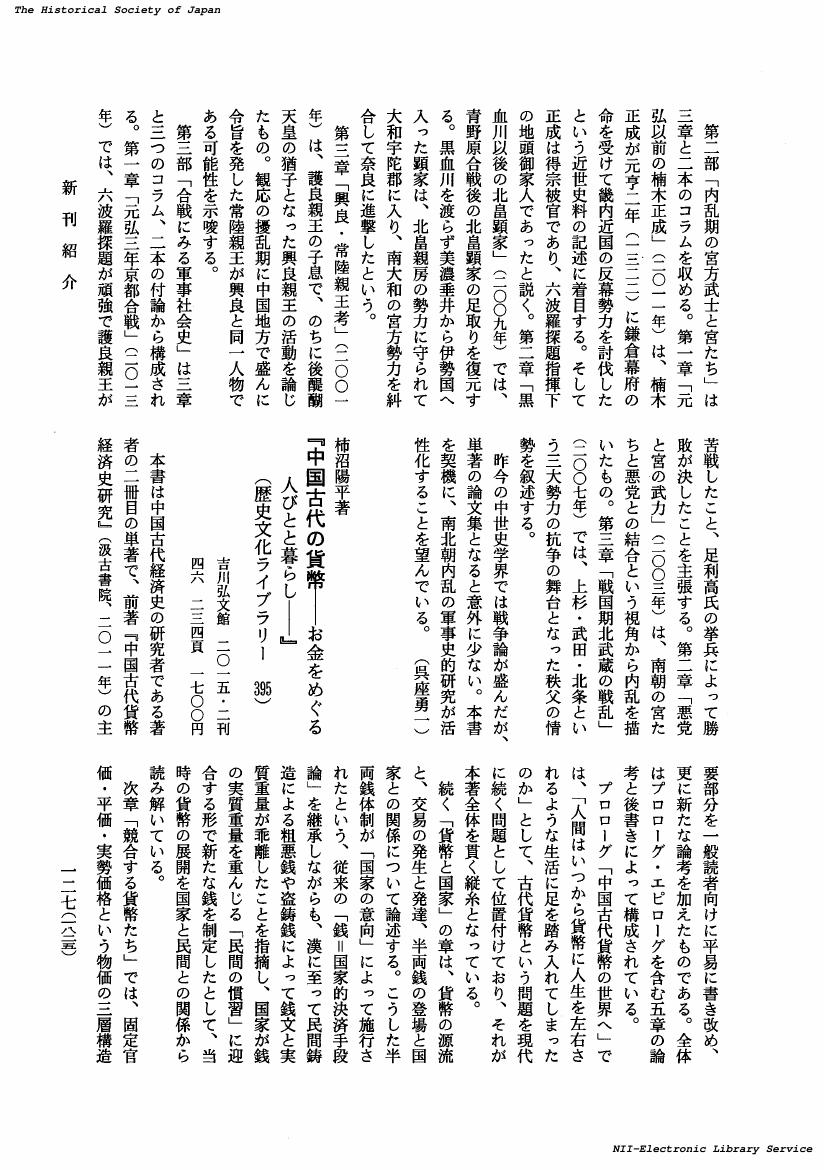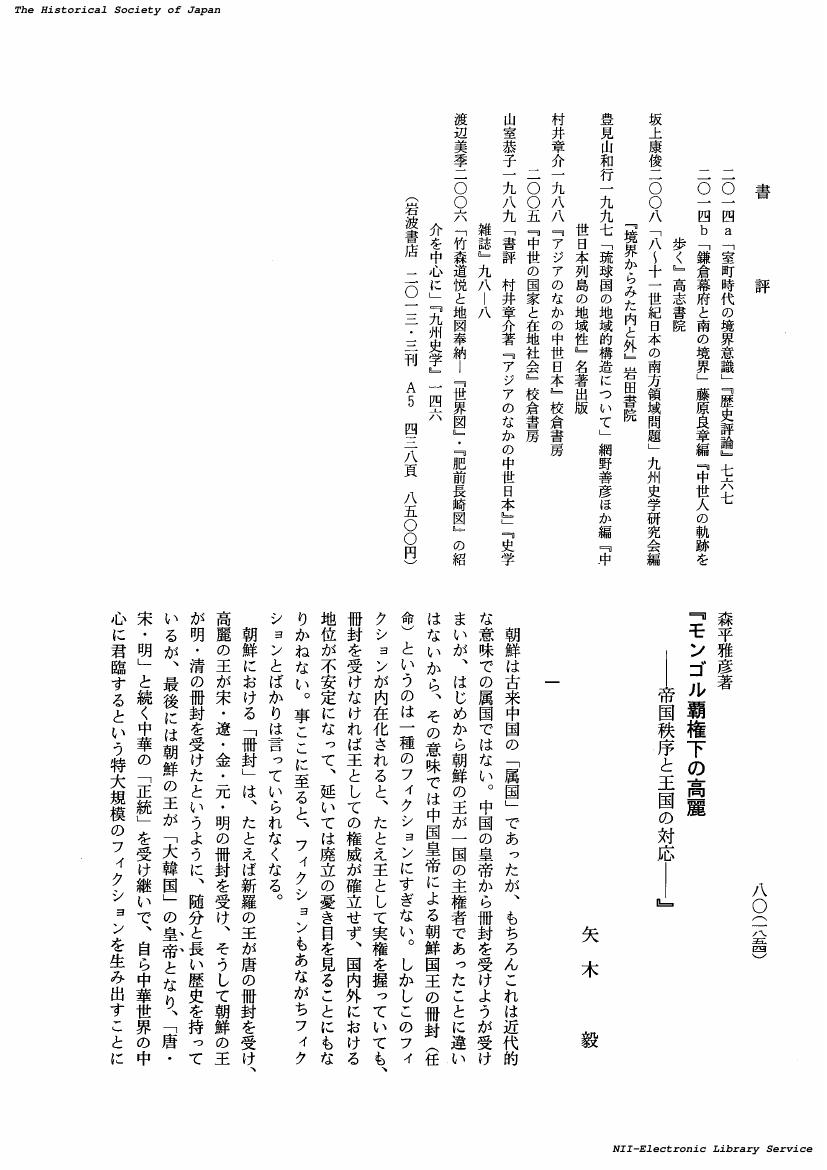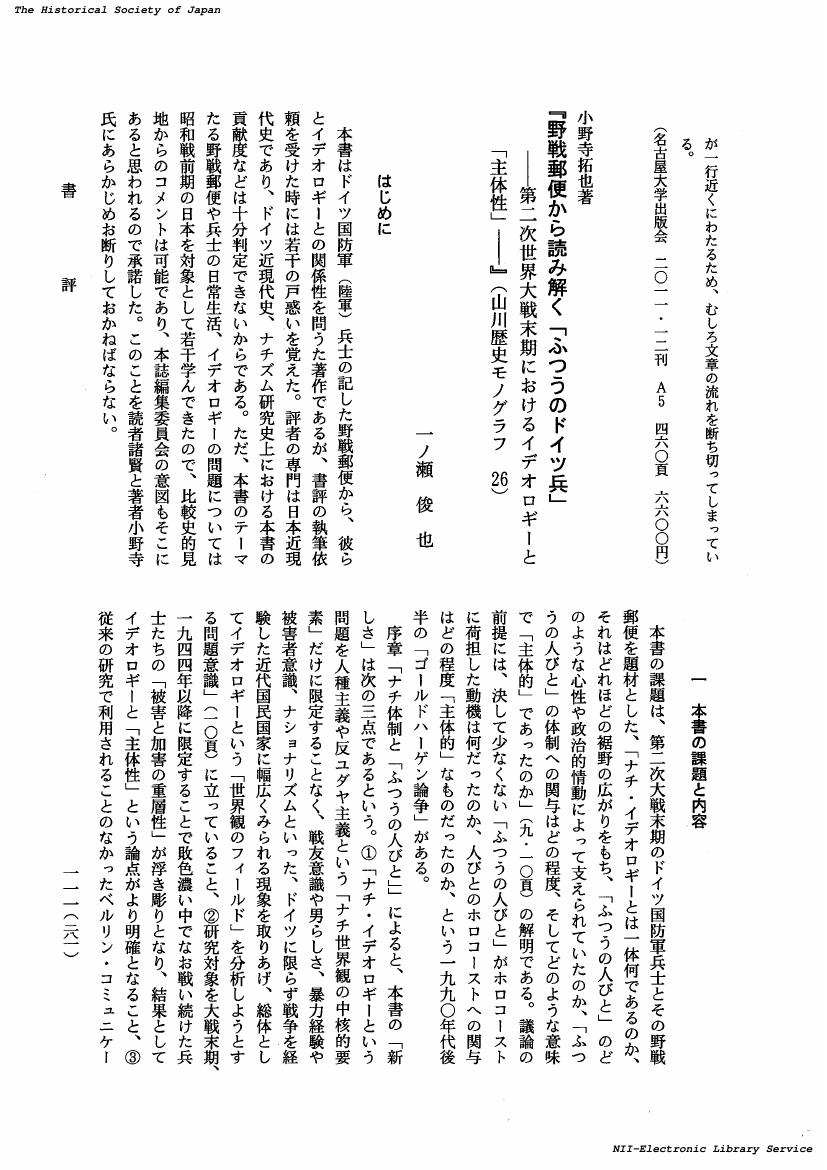1 0 0 0 OA 東アジア : 中国 : 魏晋南北朝(二〇〇〇年の歴史学界 : 回顧と展望)
- 著者
- 佐藤 佑治
- 出版者
- 公益財団法人 史学会
- 雑誌
- 史学雑誌 (ISSN:00182478)
- 巻号頁・発行日
- vol.110, no.5, pp.921-926, 2001-05-20 (Released:2017-11-30)
1 0 0 0 OA 東アジア : 中国 : 魏晋南北朝(一九九九年の歴史学界 : 回顧と展望)
- 著者
- 渡邉 義浩
- 出版者
- 公益財団法人 史学会
- 雑誌
- 史学雑誌 (ISSN:00182478)
- 巻号頁・発行日
- vol.109, no.5, pp.862-868, 2000-05-20 (Released:2017-11-30)
1 0 0 0 OA 魏晋南北朝(中国,東アジア,二〇〇九年の歴史学界-回顧と展望-)
- 著者
- 岡田 和一郎
- 出版者
- 公益財団法人 史学会
- 雑誌
- 史学雑誌 (ISSN:00182478)
- 巻号頁・発行日
- vol.119, no.5, pp.797-804, 2010-05-20 (Released:2017-12-01)
- 著者
- 東島 誠
- 出版者
- 公益財団法人 史学会
- 雑誌
- 史学雑誌 (ISSN:00182478)
- 巻号頁・発行日
- vol.105, no.7, pp.105-112, 1996-07-20 (Released:2017-11-30)
1 0 0 0 OA 一七世紀イングランド北部における法廷と地域秩序 : 国教忌避者訴追をめぐって
- 著者
- 後藤 はる美
- 出版者
- 公益財団法人 史学会
- 雑誌
- 史学雑誌 (ISSN:00182478)
- 巻号頁・発行日
- vol.121, no.10, pp.1685-1720, 2012-10-20 (Released:2017-12-01)
Catholicism, as "recusancy", became a crime prosecutable in the secular courts of early modern England after the introduction of the "recusant penal laws" during the 1580s. Recusancy, however, remained one of the least effectively prosecuted crimes throughout the seventeenth century. This was especially true in the north of England, remote from the centre and close to the northern border. The present case study concentrates on a lawsuit brought before the Star Chamber in London which was fought between groups of leading magistrates of the East Riding of Yorkshire. The case stemmed from a conflict that arouse among local justices over a much-disputed recusant prosecution at the quarter session at Pocklington (Yorkshire) in January 1615. The conflict flared up against a backdrop of heightened rivalries among leading Yorkshire gentry, which were reinforced by religious antagonism. The conflicting reactions of magisterial factions on recusant proceedings caused various interactions and subtle negotiations among the justices and between them and the grand jury, which played a crucial role in indicting recusants. The interplay among those involved, reconstructed from the interrogatories, depositions and witnesses, highlights several problems that existed in enforcing the recusant penal laws in the north of England. It also illuminates different stances adopted by individual justices and the grand jury and their influences at different points in the legal process. Furthermore, the allegations of litigants and their alleged conduct both testify to how they justified themselves at the two courts in question, one in the centre (the Star Chamber) and the other in the locality (the quarter session at Pocklington). By reconstructing process of recusant prosecution, the author describes the negotiations that took place among the conflicting justices and the grand jury, each of them acting according to the rules of law and locality. The two courts bacame strong magnetic fields to which were drawn intersecting polemics of Catholic/Protestant, old/new, and the justices/the grand jury dichotomies. It was a process in which people fought, achieved and maintained order in their locality, thus determining the practices regarding recusancy and its prosecution in the North. Furthermore, participation of individual subjects in this judicial process itself worked as an important opportunity for forging how order in the kingdom would be constituted.
- 著者
- 團藤 充己
- 出版者
- 公益財団法人 史学会
- 雑誌
- 史学雑誌 (ISSN:00182478)
- 巻号頁・発行日
- vol.120, no.2, pp.244-245, 2011-02-20 (Released:2017-12-01)
1 0 0 0 国人領主の在京活動 : 備中国新見氏と御蔵職
- 著者
- 吉永 隆記
- 出版者
- 公益財団法人 史学会
- 雑誌
- 史学雑誌 (ISSN:00182478)
- 巻号頁・発行日
- vol.122, no.8, pp.1345-1373, 2013
The research done recently on the activities of provincial-based proprietors of the warrior class (kokujin 国人) during the Muromachi and Sengoku periods tends to place emphasis on their relationship to the shoguns of the time. However, while it is clear that kokujin did profit from their connections to the shogunate while in Kyoto, their activities in the capital were by no means confined to that relationship alone. The present paper attempts to describe the actual circumstances surrounding kokujin life in the capital and thus clarify its true meaning. It was the custom of kokujin who managed the provincial estates donated to Toji temple, like the Niimi Clan of Bicchu Province, to locate kinsfolk in Kyoto in order to further their political and economic interests, including appointments to act on Toji's behalf at the temple's estates located in their home regions. In the case of the Niimi Clan, their Kyoto activities resulted in the appointment to the office of Mikurashiki 御蔵職, which involved the management of the storehouses (Kurodo-dokoro 蔵人所) and financial affairs of the imperial family and became intimately connected with iron production in various provinces. During the Tokugawa period it was the Matsugi 真継 Clan who would wrest the office of Mikurashiki from the Niimi Clan and thus govern over the country's cast iron founders ; but during the preceding Sengoku period, it was the Niimi Clan who set the precedent of imperial control over the iron founders of the Kinai Region. As the manager of Toji's Niimi Estate, the Niimi Clan was able to utilize the estate's iron production facilities to its advantage through commercial traffic with the ironmongers of the Kinai Region, whom the Niimis also employed to carry the estate's tribute to Toji temple in Kyoto. In other words, in their close dealings with Kinai merchants on the commercial routes in search of cast iron, the Niimis used these connections in their successful management of Toji's estate. It was through this process that the Niimi Clan set up its relations with the iron founders of the Kinai Region and profited from the office of Mikurashiki to the benefit of both parties. The author concludes that kokujin of the Sengoku period were ambitiously involved in the aggrandizement of their interests through their activities in the capital of Kyoto in the midst of diverse personal relationships with the capital's most powerful people, including not only the shogunate, but also the great religious institutions and the imperial family, thus protecting their interests both at their local seats of power and at the central core of authority in the capital.
1 0 0 0 OA 中世公家社会における路頭礼秩序について : 成立・沿革・所作
- 著者
- 桃崎 有一郎
- 出版者
- 公益財団法人 史学会
- 雑誌
- 史学雑誌 (ISSN:00182478)
- 巻号頁・発行日
- vol.114, no.7, pp.1237-1260, 2005-07-20 (Released:2017-12-01)
How aristocrats and their entourages were to conduct themselves whenever boarding or deboarding their carriages on the open road (rotorei 路頭礼), which is found in Koan Reisetsu 弘安礼節, a manual of style approved by imperial order in 1285, can be traced back to the 10th century work Saikyuki 西宮記, which first outlined a framework for such procedures (called shajorei 車上礼). This framework was further developed into provisions about how bureaucrats were to conduct themselves in the presence of members of the imperial family, which are contained in the early Kamakura era collection of secret traditions, Sanjo Nakayama Kuden. It was through these traditions that rotorei was either directly or indirectly compiled into the official manual, Koan Reisetsu. Since rotorei was made necessary by the Japanese social elite's use of oxen-drawn carriages, vehicles which were not used among its counterparts in China, there are no provisions in the ritsu-ryo 律令 codes regarding their use or decorum. This is why the compilers of the Koan Reisetsu were forced to turn to various Japanese folk customs to systemize rotorei practices; as one Nanbokucho era summary of the Saikyuki laments, "there are no established rules, so we should rely on what is opportune at the moment to avoid any embarrassment." Here we notice a clear contrast between rules of decorum, like rotorei, that had to be systemized from indigenous custom and those, like bajorei 馬上礼 (horsemanship decorum), which were derived from the ritsuryo codes (especially those of the Tang Dynasty). In the former, we find detailed provisions about what to do in many different situations, like whether or not the oxen have been unhitched, clearly showing that in the case of any trouble, the parties involved would have use their own imaginations, a rule of thumb that also characterizes the manual of style regarding personal correspondence. We also find oral tradition and actual incidents from diaries, etc. being examined as precedents for conduct regarding such aspects as "backing the carriage,""unhitching the oxen,""positioning the step,""deboarding,""climbing down postures" and "bowing (prostrating) after deboarding." Such rules of deportment and the degree to which they were respected may add to a better understanding of the circumstances surrounding such incidents as Taira-no-Nobukane's arrow attack on Fujiwara-no-Yorinaga's carriage procession during the Hogen Civil War.
- 著者
- 佐々木 満実
- 出版者
- 公益財団法人 史学会
- 雑誌
- 史学雑誌 (ISSN:00182478)
- 巻号頁・発行日
- vol.124, no.10, pp.1825-1826, 2015-10-20 (Released:2017-07-31)
1 0 0 0 OA 十七世紀後半ハルハ=モンゴルの権力構造とその淵源 右翼のチベット仏教僧に着目して
- 著者
- 前野 利衣
- 出版者
- 公益財団法人 史学会
- 雑誌
- 史学雑誌 (ISSN:00182478)
- 巻号頁・発行日
- vol.126, no.7, pp.1-33, 2017 (Released:2018-10-20)
十七世紀のモンゴル高原には、ハルハ=モンゴルという集団が左翼(東方)と右翼(西方)に分かれて遊牧していた。これまでの研究では、左翼の知見に基づいてハルハの全体像を描いてきたが、実像を知るには右翼の研究が必要である。そこで本稿では、右翼のチベット仏教界を取り上げ、ハルハの全体像の解明に挑戦し、以下の点を明らかにした。 当時のハルハの高僧と言えば左翼のジェブツンダンバ一世が有名であるが、右翼をなす三王家(ハーン家、ジノン家、ホンタイジ家)にも転生僧がそれぞれおり、彼らは当主に次ぐ莫大な属民を有し、清・チベット・ロシアと交渉する等、政治的に重要な役割を果たしていた。ハーンらがこうした転生僧を重用したのは、転生僧が十六世紀後半のチベット屈指の学僧の系譜に連なる高僧であっただけでなく、彼らがそれぞれ右翼三王家の当主の近親者であったからだと考えられる。 右翼におけるハーンと転生僧との政治的な提携関係は、左翼のトゥシェート=ハーン・ジェブツンダンバ兄弟の連携と酷似しており、従来特異な事例とされてきた左翼の聖俗連携の体制は、実はこの時代のハルハ全体に共通するものだったことが明らかになる。 かかる権力構造のパターンは、右翼のホンタイジ家で発展したものである。初代ホンタイジには側近として外交交渉を担う高僧がおり、第二代ではその外戚の高僧が同じ役割を果たし、第三代では当主の弟である転生僧が活躍した。つまり、十七世紀後半の全ハルハに現れた聖俗連携の権力構造は、左翼ではなく右翼において、十六世紀から三代かけて代替わりごとに発展してきたものだったのである。 以上本稿では、十七世紀後半のハルハにはボルジギン氏族の当主とその近親者たる高僧による聖俗連携の権力構造が現出し、そのパターンは右翼で成立したことを明らかにした。
- 著者
- 山口 元樹
- 出版者
- 公益財団法人 史学会
- 雑誌
- 史学雑誌 (ISSN:00182478)
- 巻号頁・発行日
- vol.124, no.1, pp.135, 2015-01-20 (Released:2017-12-01)
- 著者
- 姫岡 とし子
- 出版者
- 公益財団法人 史学会
- 雑誌
- 史学雑誌 (ISSN:00182478)
- 巻号頁・発行日
- vol.124, no.1, pp.111-112, 2015-01-20 (Released:2017-12-01)
- 著者
- 小池 求
- 出版者
- 公益財団法人 史学会
- 雑誌
- 史学雑誌 (ISSN:00182478)
- 巻号頁・発行日
- vol.124, no.1, pp.137, 2015-01-20 (Released:2017-12-01)
- 著者
- 辻 英史
- 出版者
- 公益財団法人 史学会
- 雑誌
- 史学雑誌 (ISSN:00182478)
- 巻号頁・発行日
- vol.124, no.1, pp.142, 2015-01-20 (Released:2017-12-01)
- 著者
- 熊野 直樹
- 出版者
- 公益財団法人 史学会
- 雑誌
- 史学雑誌 (ISSN:00182478)
- 巻号頁・発行日
- vol.124, no.3, pp.417-425, 2015-03-20 (Released:2017-12-01)
- 著者
- 李 龢書
- 出版者
- 公益財団法人 史学会
- 雑誌
- 史学雑誌 (ISSN:00182478)
- 巻号頁・発行日
- vol.122, no.6, pp.1143-1144, 2013-06-20 (Released:2017-12-01)
- 著者
- 矢木 毅
- 出版者
- 公益財団法人 史学会
- 雑誌
- 史学雑誌 (ISSN:00182478)
- 巻号頁・発行日
- vol.123, no.10, pp.1854-1863, 2014-10-20 (Released:2017-07-31)
- 著者
- 入江 幸二
- 出版者
- 公益財団法人 史学会
- 雑誌
- 史学雑誌 (ISSN:00182478)
- 巻号頁・発行日
- vol.123, no.1, pp.139, 2014-01-20 (Released:2017-07-31)
- 著者
- 一ノ瀬 俊也
- 出版者
- 公益財団法人 史学会
- 雑誌
- 史学雑誌 (ISSN:00182478)
- 巻号頁・発行日
- vol.123, no.2, pp.281-289, 2014-02-20 (Released:2017-07-31)
- 著者
- 若尾 祐司
- 出版者
- 公益財団法人 史学会
- 雑誌
- 史学雑誌 (ISSN:00182478)
- 巻号頁・発行日
- vol.123, no.1, pp.108-114, 2014-01-20 (Released:2017-07-31)















